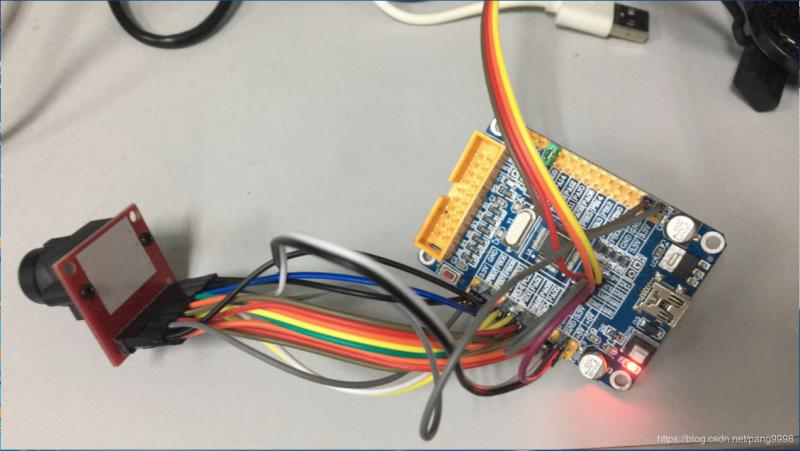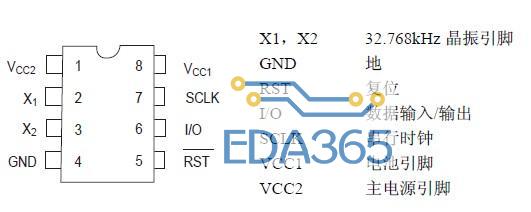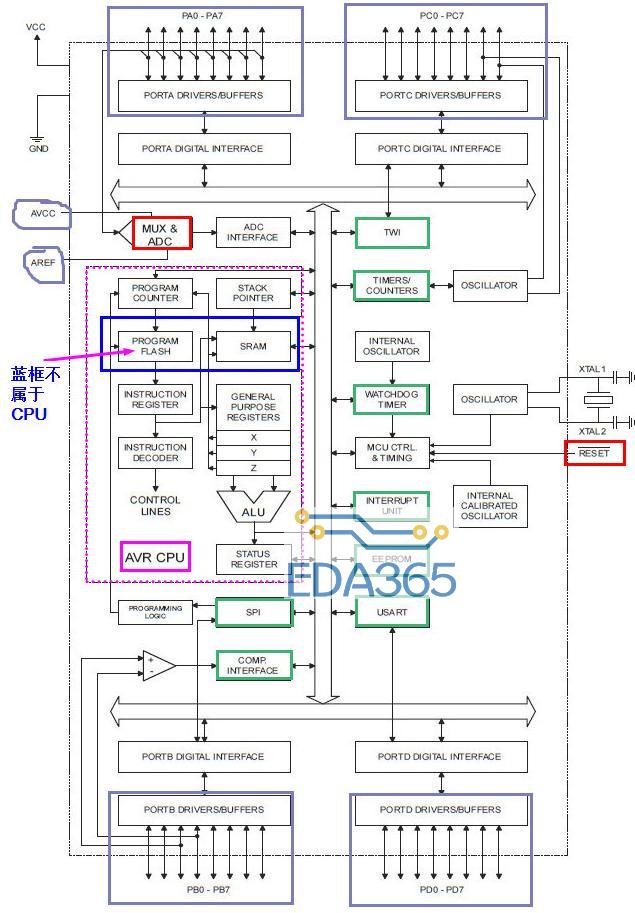本文基于FL2440 ARM开发板
Linux内核版本 2.6.28.7
arm-linux-gcc 3.4.1
- #include
- #include
- #include
- #include
- #include
- #include /*设置中断方式*/
- #include
- #include
- #include
- #include
- #include
- //设备名
- #define IO_DEVICE_NAME "my_io"
- //主设备号
- #define IO_DEVICE_MAJOR 240
- //次设备号
- #define IO_DEVICE_SECONDARY 32
- //返回一个数x的第y位
- #define MYBIT(x,y) ((x>>y)%2)
- #ifndef _LINUX_IRQRETURN_H
- #define _LINUX_IRQRETURN_H
- typedef int irqreturn_t;
- #define IRQ_EINT0 0
- #define IRQ_EINT2 2
- #define IRQ_EINT3 3
- #define IRQ_EINT4 32
- #define IRQ_NONE (0)
- #define IRQ_HANDLED (1)
- #define IRQ_RETVAL(x) ((x) != 0)
- #endif
- /*
- * S3C2410 GPIO edge detection for IRQs:
- * IRQs are generated on Falling-Edge, Rising-Edge, both, low level or higg level.
- * This must be called *before* the corresponding IRQ is registered.
- */
- #define EXT_LOWLEVEL 0
- #define EXT_HIGHLEVEL 1
- #define EXT_FALLING_EDGE 2
- #define EXT_RISING_EDGE 4
- #define EXT_BOTH_EDGES 6
- static int flag_0,flag_2;//中断转换标志
- static int cnt;
- DECLARE_WAIT_QUEUE_HEAD(io_wait);//声明等待队列
- void io_con_set();
- static irqreturn_t io_interrupt_0(int irq,void * dev_id,struct pt_regs *regs)
- {
- printk("**********the interrupt 0 works**********/n");
- if(flag_0==0)
- {
- cnt=(cnt+1)%2;
- flag_0=1;
- if(cnt==0)
- {
- printk("IN/n");
- s3c2410_gpio_setpin(S3C2410_GPB5,0);
- s3c2410_gpio_setpin(S3C2410_GPB6,1);
- }
- wake_up_interruptible(&io_wait);
- }
- return IRQ_HANDLED;
- }
- static irqreturn_t io_interrupt_2(int irq,void * dev_id,struct pt_regs *regs)
- {
- printk("**********the interrupt 2 works**********/n");
- if(flag_2==0)
- {
- cnt=(cnt+1)%2;
- flag_2=1;
- if(cnt==0)
- {
- printk("OUT/n");
- s3c2410_gpio_setpin(S3C2410_GPB5,1);
- s3c2410_gpio_setpin(S3C2410_GPB6,0);
- }
- wake_up_interruptible(&io_wait);
- }
- return IRQ_HANDLED;
- }
- static int io_open(struct inode * inode,struct file * file)//打开设备函数
- {
- int ret;
- set_irq_type(IRQ_EINT0,EXT_FALLING_EDGE);//设置中断0 触发方式
- set_irq_type(IRQ_EINT2,EXT_FALLING_EDGE);//设置中断2 触发方式
- // EXT_LOWLEVEL
- // EXT_HIGHLEVEL
- // EXT_FALLING_EDGE
- // EXT_RISING_EDGE
- // EXT_BOTH_EDGES
- disable_irq(IRQ_EINT0);
- disable_irq(IRQ_EINT2);
- enable_irq(IRQ_EINT0);
- enable_irq(IRQ_EINT2);
- ret=request_irq(IRQ_EINT0,io_interrupt_0,IRQF_SHARED,IO_DEVICE_NAME,1);//注册中断0
- if(ret<0)
- {
- printk("IRQ %d can not request/n",IRQ_EINT0);
- return ret;
- }
- ret=request_irq(IRQ_EINT2,io_interrupt_2,IRQF_SHARED,IO_DEVICE_NAME,1);//注册中断2
- if(ret<0)
- {
- printk("IRQ %d can not request/n",IRQ_EINT2);
- return ret;
- }
- printk("the device is opened/n");
- io_con_set();
- cnt=0;
- return 0;
- }
- void io_con_set()//IO端口控制寄存器初始化
- {
- s3c2410_gpio_cfgpin(S3C2410_GPF0,S3C2410_GPF0_EINT0);
- s3c2410_gpio_cfgpin(S3C2410_GPF2,S3C2410_GPF2_EINT2);
- s3c2410_gpio_cfgpin(S3C2410_GPB5,S3C2410_GPB5_OUTP);
- s3c2410_gpio_cfgpin(S3C2410_GPB6,S3C2410_GPB6_OUTP);
- }
- static int io_close(struct inode * inode,struct file * file)//设备关闭函数
- {
- free_irq(IRQ_EINT0,1);//释放中断
- free_irq(IRQ_EINT2,1);//释放中断
- printk("the device is closed/n");
- return 0;
- }
- static ssize_t io_read(struct file * filp,char * buff,size_t count,loff_t * f_ops)//读取IO端口
- {
- wait_event_interruptible(io_wait,flag_0);
- wait_event_interruptible(io_wait,flag_0);
- flag_0=0;
- flag_2=0;
- //printk("the value is %d/n",io_data);
- copy_to_user(buff,(char *)&cnt,sizeof(cnt));
- }
- static struct file_operations io_device_fops =
- {
- .owner=THIS_MODULE,
- .read=io_read,
- .open=io_open,
- .release=io_close,
- };
- static int __init io_init(void)//insmod加载驱动时执行
- {
- int ret;
- ret=register_chrdev(IO_DEVICE_MAJOR,IO_DEVICE_NAME,&io_device_fops);
- if(ret<0)
- {
- printk("Fail to regist the device/n");
- return ret;
- }
- return 0;
- }
- static int __exit io_exit(void)//rmmod卸载驱动时执行
- {
- unregister_chrdev(IO_DEVICE_MAJOR,IO_DEVICE_NAME);
- printk("the device has been unregisted/n");
- }
- module_init(io_init);
- module_exit(io_exit);
- MODULE_LICENSE("GPL");
Makefile同上一篇的Makefile
obj-m := my_io.o
KERNELDIR ?= /arm/linux-2.6.28.7-2440
PWD := $(shell pwd)
default:
$(MAKE) -C $(KERNELDIR) M=$(PWD) modules
clean:
rm -f *.o *.ko *.order *.symvers
这次本人修改了下内核头文件的目录,将目录./arch/arm/include下asm文件夹复制到./include
将目录./arch/arm/mach-s3c2410/include下mach文件夹复制到./include下
驱动修改版
- #include
- #include
- #include
- #include
- #include
- #include /*设置中断方式*/
- #include
- #include
- #include
- #include
- #include
- //设备名
- #define IO_DEVICE_NAME "my_io"
- //主设备号
- #define IO_DEVICE_MAJOR 240
- //次设备号
- #define IO_DEVICE_SECONDARY 32
- //返回一个数x的第y位
- #define MYBIT(x,y) ((x>>y)%2)
- #ifndef _LINUX_IRQRETURN_H
- #define _LINUX_IRQRETURN_H
- typedef int irqreturn_t;
- #define IRQ_EINT0 0
- #define IRQ_EINT2 2
- #define IRQ_EINT3 3
- #define IRQ_EINT4 32
- #define IRQ_NONE (0)
- #define IRQ_HANDLED (1)
- #define IRQ_RETVAL(x) ((x) != 0)
- #endif
- /*
- * S3C2410 GPIO edge detection for IRQs:
- * IRQs are generated on Falling-Edge, Rising-Edge, both, low level or higg level.
- * This must be called *before* the corresponding IRQ is registered.
- */
- #define EXT_LOWLEVEL 0
- #define EXT_HIGHLEVEL 1
- #define EXT_FALLING_EDGE 2
- #define EXT_RISING_EDGE 4
- #define EXT_BOTH_EDGES 6
- static int flag_0,flag_2;//中断转换标志
- static int cnt;
- DECLARE_WAIT_QUEUE_HEAD(io_wait);//声明等待队列
- void io_con_set();
- static irqreturn_t io_interrupt_0(int irq,void * dev_id,struct pt_regs *regs)
- {
- if(flag_0==0)
- {
- printk("**********the interrupt 0 works**********/n");
- cnt=(cnt+1)%2;
- flag_0=1;
- if(cnt==0)
- {
- printk("IN/n");
- s3c2410_gpio_setpin(S3C2410_GPB5,0);
- s3c2410_gpio_setpin(S3C2410_GPB6,1);
- }
- wake_up_interruptible(&io_wait);
- }
- return IRQ_HANDLED;
- }
- static irqreturn_t io_interrupt_2(int irq,void * dev_id,struct pt_regs *regs)
- {
- if(flag_2==0)
- {
- printk("**********the interrupt 2 works**********/n");
- cnt=(cnt+1)%2;
- flag_2=1;
- if(cnt==0)
- {
- printk("OUT/n");
- s3c2410_gpio_setpin(S3C2410_GPB5,1);
- s3c2410_gpio_setpin(S3C2410_GPB6,0);
- }
- wake_up_interruptible(&io_wait);
- }
- return IRQ_HANDLED;
- }
- static int io_open(struct inode * inode,struct file * file)//打开设备函数
- {
- int ret;
- set_irq_type(IRQ_EINT0,EXT_FALLING_EDGE);//设置中断0 触发方式
- set_irq_type(IRQ_EINT2,EXT_FALLING_EDGE);//设置中断2 触发方式
- // EXT_LOWLEVEL
- // EXT_HIGHLEVEL
- // EXT_FALLING_EDGE
- // EXT_RISING_EDGE
- // EXT_BOTH_EDGES
- disable_irq(IRQ_EINT0);
- disable_irq(IRQ_EINT2);
- enable_irq(IRQ_EINT0);
- enable_irq(IRQ_EINT2);
- ret=request_irq(IRQ_EINT0,io_interrupt_0,IRQF_SHARED,IO_DEVICE_NAME,1);//注册中断0
- if(ret<0)
- {
- printk("IRQ %d can not request/n",IRQ_EINT0);
- return ret;
- }
- ret=request_irq(IRQ_EINT2,io_interrupt_2,IRQF_SHARED,IO_DEVICE_NAME,1);//注册中断2
- if(ret<0)
- {
- printk("IRQ %d can not request/n",IRQ_EINT2);
- return ret;
- }
- printk("the device is opened/n");
- io_con_set();
- cnt=0;
- return 0;
- }
- void io_con_set()//IO端口控制寄存器初始化
- {
- s3c2410_gpio_cfgpin(S3C2410_GPF0,S3C2410_GPF0_EINT0);
- s3c2410_gpio_cfgpin(S3C2410_GPF2,S3C2410_GPF2_EINT2);
- s3c2410_gpio_cfgpin(S3C2410_GPB5,S3C2410_GPB5_OUTP);
- s3c2410_gpio_cfgpin(S3C2410_GPB6,S3C2410_GPB6_OUTP);
- }
- static int io_close(struct inode * inode,struct file * file)//设备关闭函数
- {
- free_irq(IRQ_EINT0,1);//释放中断
- free_irq(IRQ_EINT2,1);//释放中断
- printk("the device is closed/n");
- return 0;
- }
- static ssize_t io_read(struct file * filp,char * buff,size_t count,loff_t * f_ops)//读取IO端口
- {
- wait_event_interruptible(io_wait,flag_0&flag_2);
- flag_0=0;
- flag_2=0;
- //printk("the value is %d/n",io_data);
- copy_to_user(buff,(char *)&cnt,sizeof(cnt));
- }
- static struct file_operations io_device_fops =
- {
- .owner=THIS_MODULE,
- .read=io_read,
- .open=io_open,
- .release=io_close,
- };
- static int __init io_init(void)//insmod加载驱动时执行
- {
- int ret;
- ret=register_chrdev(IO_DEVICE_MAJOR,IO_DEVICE_NAME,&io_device_fops);
- if(ret<0)
- {
- printk("Fail to regist the device/n");
- return ret;
- }
- return 0;
- }
- static int __exit io_exit(void)//rmmod卸载驱动时执行
- {
- unregister_chrdev(IO_DEVICE_MAJOR,IO_DEVICE_NAME);
- printk("the device has been unregisted/n");
- }
- module_init(io_init);
- module_exit(io_exit);
- MODULE_LICENSE("GPL");
这个驱动实际上是通过红外传感器检测电平变化,来实现人数的统计,改进后能够实现正确的通过中断先后来识别方向,还排除了单一中断的
抖动干扰。
关键字:控制IO端口 s3c2410『本文转载自网络,版权归原作者所有,如有侵权请联系删除』
 热门文章
更多
热门文章
更多









